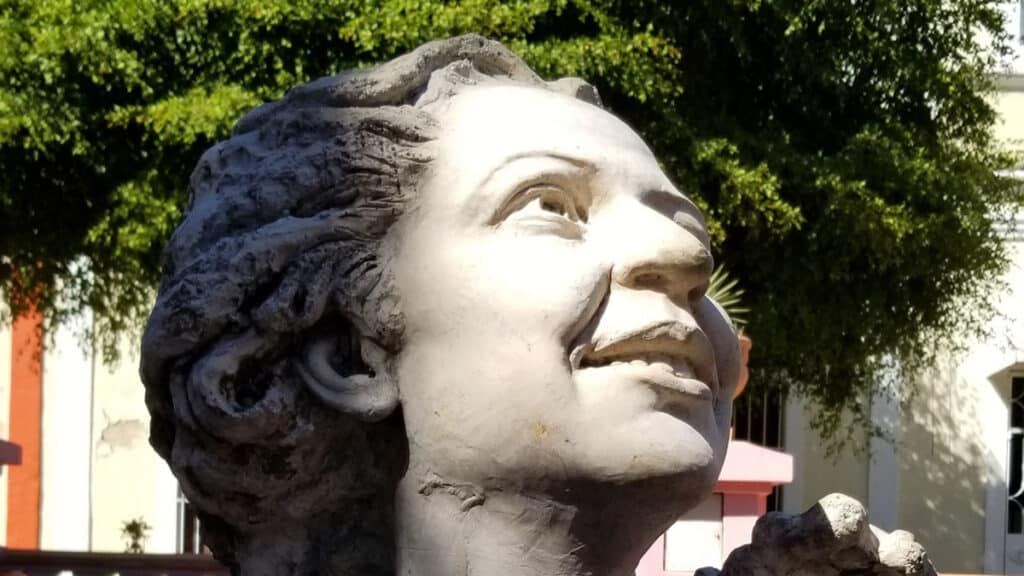Julia De Burgos, (1914-1953), was a renowned Puerto Rican poet and human rights activist. Her writings show a strength and independence that preceded the women’s rights movement in the United States by twenty years.
En todo me lo juego a ser lo que soy yo”
“Songfest: A Cycle of American Poems for Six Singers and Orchestra” (1977) by Leonard Bernstein with words from the “A Julia de Burgos” poem
(I gamble it all to be exactly as I am)
De Burgos explored themes of colonialism, human enslavement, and imperialism. These are common themes in Puerto Rican culture, almost as if they are genetically coded in Puerto Rican DNA. But if you are not Puerto Rican and able to get outside of yourself for a moment, you might recognize that these themes have the same relevance whether you are descended from the colonizer-slaver-imperialist or the colonized- enslaved-imperialized. From the spring that feeds the great river of Puerto Rico, Julia de Burgos touches our common humanity.
Young people today tend to be much more evolved, but for De Burgos to do what she did in her time was exceptional. She was a divorced, working class woman with an African heritage who worked in a Catholic, machista (male chauvinist) society where women were supposed to just stay at home, and divorce was frowned on.
A Child of the Land and a Woman of the People

Julia was born February 17, 1914 near Carolina, Puerto Rico. Raised poor, Puerto Rican poor, she was the oldest of thirteen children. Perhaps being the oldest child is the source of her independent nature. Her first and perhaps most famous poem is “Río Grande de Loíza,” about growing up along Puerto Rico’s great river.
El Río Grande de Loíza really is a beautiful place. You used to cross it by ferry, but there is a bridge now. Loíza is famously the Puerto Rican town with the strongest African Diaspora culture. It’s a center of Bomba Puertorriqueña, home of El Batey Ayala. The Taíno sacred mountain, El Yunque, looks over everything.
My childhood was all a poem in the river, and a river in the poem of my first dreams.”
Julia de Burgos “Río Grande de Loíza,” translated from Spanish by Vanessa Pérez Rosario
The writer graduated from University of Puerto Rico and became a teacher. She stopped teaching after marrying at age twenty.
Her first husband was a Puerto Rican nationalist, but it is perhaps an overemphasized association. All people want to breath the free air, especially a people associated with the United States, the “land of the free.”
Being denied one’s natural freedom creates the eternal ache, el lamento Boliviano. This is one of life’s hurts that creates great artists. Creatives must create, no matter what. What can’t be expressed one way (nationality) gets expressed another way (art).
The island of Puerto Rico and the Spanish language are both overflowing with a natural poetry. This and the search for identity may explain Puerto Rican dominance of popular music with salsa, reggaeton and Latin trap.
Looking up at the hills of Puerto Rico often recalls the great Neruda poem “Cuerpo de mujer” (Body of a Woman). It begins “Body of a woman, white hills, white thighs, you look like the world in your attitude of surrender” (translated from the original Spanish). Though she married many times, De Burgos was probably not the type of woman to surrender. Seems like she tried it, but didn’t like it.
It’s been written that De Burgos could recite by heart all of Pablo Neruda’s “Viente poemas de amor y una canción desesperada” (20 Poems of Love and a Song of Despair). At the age of 24, she self-published her first poetry collection “Poema en viente surcos” (Poem in Twenty Furrows) in 1938. The title probably has something to do with her admiration for Neruda. It’s an expression of love for the land by a woman raised in a family of farmers.
The richness of her writing offered access to elite Puerto Rican circles, but in those days Puerto Rico wasn’t ready for a divorced woman with an African heritage. When she left Puerto Rico, she promised never to return.
De Burgos spent time in Cuba (pre-controversy Cuba) where she studied at the University of Havana which at the time was probably the best university in the Caribbean, or even South America. There, she met her idol Pablo Neruda who said she was destined to be one of the greatest poets of the Americas.
Julia De Burgos in New York City
In New York, De Burgos was a journalist for “Pueblos Hispanos” (Hispanic Communities). In the early 1940s, she moved back and forth between Cuba and New York City.
Like many artists, she suffered from depression and alcoholism, and the health problems that go with that. A heart that is broken many times will do that to you. While living in Brooklyn, she disappeared one day in 1953. It was later discovered that she collapsed with pneumonia in El Barrio East Harlem on July 6, 1953 and died at a hospital in Harlem.
Originally buried anonymously on Hart Island, New York City, her remains were moved to the Cementerio Municipal de Carolina.
Like many artists, Julia de Burgos may be more loved in death than in life. She is one of the icons of Puerto Rican identity.
The Julia de Burgos Cultural Arts Center in El Barrio East Harlem, New York City is named after the great poet. juliadeburgos.org
Río Grande de Loíza! Río Grande. Big cry.
Julia de Burgos “Río Grande de Loíza,” translated from Spanish by Vanessa Pérez Rosario
The greatest of all our island cries,
if it were not greater, the one that leaves me
through the eyes of the soul of my slave people.”
